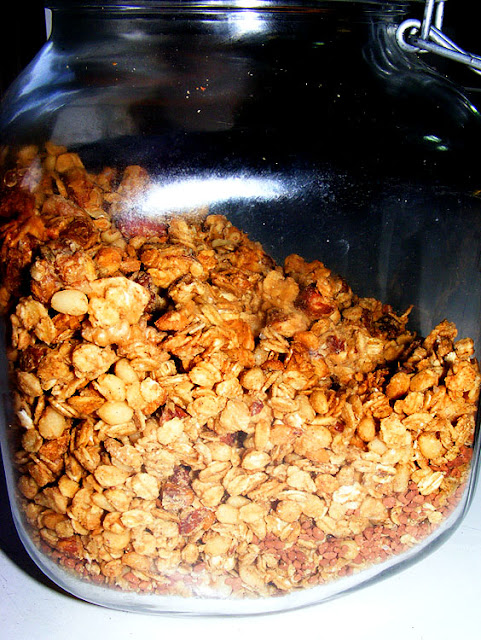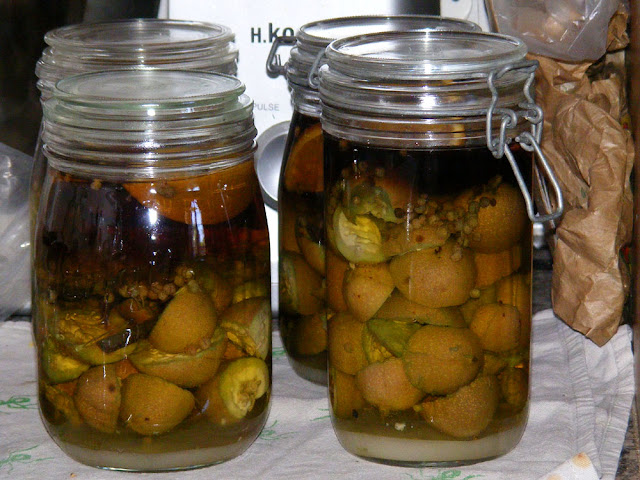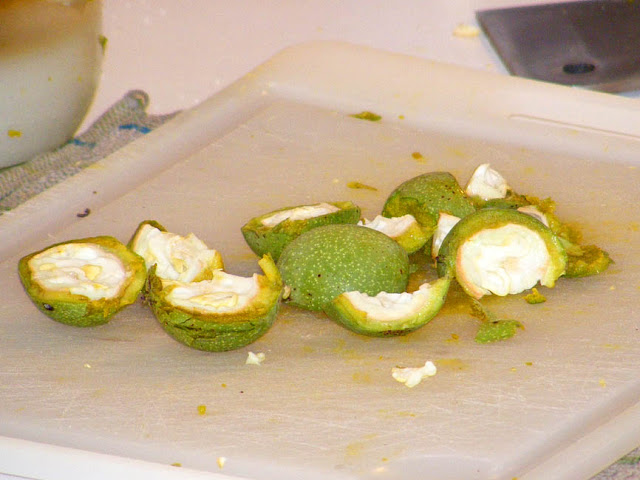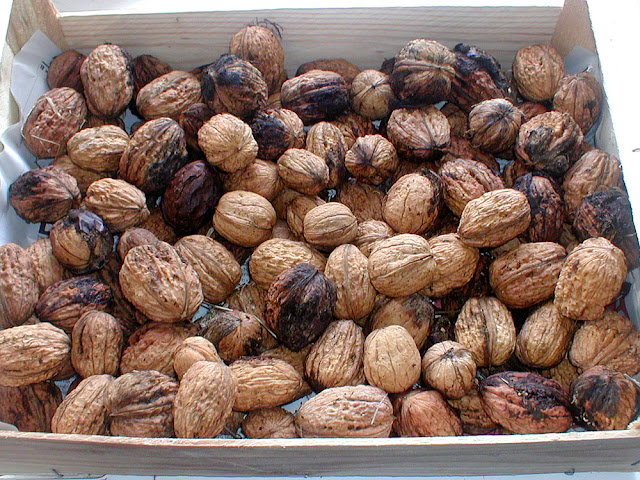The Touraine Loire Valley is famous for its walnuts (Fr. les noix), although it does not hold an AOC for them as some other regions such as Dordogne do. Still, there is a walnut tree in almost every field and along roadsides. There is no real need to possess your own walnut to secure a year round supply – just go for a walk in October and pick them up off the ground – everyone does it.
 |
| Homemade granola. |
There was an elderly man who used to come to the market in Preuilly. He sold the excess of whatever he was growing in his garden, and I sometimes bought lettuce, onions, garlic or potatoes from him. Although I have my own walnut trees, I sometimes also bought walnuts, and the reason is that I could buy this season's freshly shelled nuts from him. I could also buy unshelled walnuts from him, but since 1kg of unshelled or 500g of shelled is the same number of nuts and the same price it seemed mad to buy the unshelled. According to him, there are 40 walnuts to a kilo, and they net you une livre (a pound) of shelled nuts. He charged €3 a bag, shelled or unshelled. He always refers to half a kilo as une livre, and recommends the nuts as a nibble to go with an aperitif.
 |
| Homegrown walnuts. |
Shelling the autumn crop of walnuts is a winter task, done in front of the fire. I normally freeze shelled walnuts so they don't go rancid, and use them over the course of the year until the next harvest comes in. I make my own granola to use up the last of the previous years walnuts in the freezer.
One of the most traditional ways of using walnuts here is in walnut bread. Very few people make it at home, but it is regularly available at the boulangerie, especially during foie gras season, as it can be used as an alternative to brioche to serve with foie gras.
 |
| Goats cheese, walnuts and rosemary, ingredients for savoury biscotti. |
Every few years I make liqueur de noix. This is what the Italians call nocino and many people know it by that name, not realising that the French make it too. For this I need a couple of dozen green walnuts. Traditionally they are harvested in mid- to late June, around Saint John's Day, which is today. You have to catch the fruit before the nutshell inside has got woody. The green fruits are fairly tough all the same, and you have to hack them to bits with a cleaver.
 |
| Green walnuts for homemade liqueur. |
Liqueur de noix is an infusion of chopped up green walnuts in vodka with sugar, spices and lemon zest. Walnuts contain a strong dye which reacts with the air to stain yellow and then progressively darker and darker until it is a very dark brown. Most instructions for making liqueur de noix carry on alarmingly about how the walnut juice will permanently stain everything it touches, but my experience is that if you just wash everything immediately after making the concoction, there isn't a problem. Cherries are much worse in my opinion, in terms of staining your fingers, clothing and spraying the wall with juice that doesn't come off paintwork.
 |
| Homemade pear and walnut cake, served with Pineau de Charentes. |
 |
| Homemade savoury biscotti with walnuts and Sainte Maure de Touraine goats cheese. |
 |
| Homemade walnut liqueur on Day 6. |
At first, it's a pleasant enough looking brew...but after 24 hours the chemical reaction causing the dark colour is well under way. After three days it looks like you are habouring some sort of nuclear waste product, with the green walnut skins glowing lime green through the British racing green of the liquid.
By Christmas time it can be filtered and put in bottles ready for consumption. The longer you let it mature the smoother it becomes. Depending on your walnuts it will be more or less nutty, often with a touch of bitterness. It goes well on vanilla ice cream and I often use it in any recipe I think is robust enough to take it, where the original recipe calls for amaretto.
 |
| Walnuts are normally gathered after they fall naturally to the ground. There is a walnut in the centre of this picture, which gives you a good idea of how camouflaged they can be. |
Another use for walnuts I like is to make savoury biscuits. We anglophones tend to think of biscotti as an Italian classic, but actually these hard crisp biscuits exist in other European culinary traditions too. In France they are called croquets or croquants by people in conversation and by artisan bakers, although in the supermarket they will often be labelled 'biscotti'. A friend made some to hand round after a botany outing. She was bemused by me apparently suddenly switching from French to Italian, and told me the biscuits were called croquants.
 |
| Homegrown green walnuts, chopped up for making liqueur. |
The recipe below is my savoury take on the subject, using local Loire Valley (tourangeaux) ingredients.
Savoury Goats Cheese and Walnut Biscotti (Croquants au chèvre et aux noix)
Ingredients
125 g walnuts
2¼ cups flour
60 g mature dry goats cheese
¼ cup maize meal or polenta
1 tbsp sugar
1½ tsp baking powder
½ tsp baking soda
1½ tsp salt
¼ tsp piment d'Espelette
2 eggs
150 ml buttermilk
1 tbsp fresh thyme or rosemary leaves
Method
1. Turn the oven on to 180°C.
2. Roast the nuts in the oven for about 8 minutes.
3. Grate, crumble or chop the cheese, depending on its consistency.
4. Remove the nuts from the oven and allow to cool. Leave the oven on.
5. Mix together the flour, cheese, maize meal, sugar, baking powder, baking soda, salt and piment d'Espelette.
6. Roughly chop the walnuts and add to the dry ingredient mix.
7. In a separate bowl beat the eggs with the buttermilk and thyme.
8. Pour the wet mixture into a well in the dry mixture and work it with a fork and then your hands until it forms a fairly stiff dough.
9. Divide into 4.
10. Roll each quarter into a sausage about 25 cm long and put on an oven tray lined with a silicone sheet or baking paper. If it is a bit sticky, sprinkle the work surface with a little flour. Space the logs about 10 cm apart and use two trays.
11. Bake for 20 minutes, then remove and cool for a couple of minutes.
12. Turn the oven down to 100°C.
13. Using a bread knife, cut the logs into slices. Angle the knife diagonally to get long oval slices.
14. Put the slices back on the lined oven trays and put back in the oven for 30-40 minutes.
- Piment d'Espelette is a mild chilli powder from the Pyrenees. It's expensive and not available everywhere, so use hot paprika instead if you want.
- If buttermilk (lait ribot or lait fermenté in France) isn't available where you are, use plain yoghurt.
- The biscotti will not be as brittle as the classic sweet version, because of the cheese. They are very savoury and moreish though.
 |
| The last walnut hangs on in November in our orchard. |
Some people gather as many walnuts as they can, so they can take them to the huilerie where they will get them pressed into oil. One of my neighbours tells me it costs a couple of euros per litre to have them pressed, but unless you have a minimum of 40 kg of nuts, you have to share a pressing with other small scale clients and the output is divided up proportionally. Apparently they will also make oil from your hazelnuts, and you can buy oil from them for a few euros a litre (less than half the price of buying it from the supermarket, where it is about €12 a litre).
 |
| There are seriously walnut trees absolutely everywhere here. |
Sometimes I get some of this 'homegrown' oil given to me, bottled in recycled plastic water bottles, and so strongly flavoured that it completely overpowers any salad it dresses. It's great for flavouring cakes though, so it doesn't go to waste.
 |
| Homemade walnut liqueur. |
We are also on Instagram, so check us out to see a regularly updated selection of our very best photos. You may also like to check out our YouTube channel.



1 comment:
"Cherries are much worse in my opinion, in terms of staining your fingers, clothing and spraying the wall with juice that doesn't come off paintwork."
Unokidee!! We now have a system that catches most.... two chopping sheets stood vertically at right angles... cherry pitter aimed into the angle... operator dressed in full wet suit, goggles and snorkle [flippers an optopn!]
"There is no real need to possess your own walnut to secure a year round supply – just go for a walk in October and pick them up off the ground – everyone does it."
But not all walnuts are "public".... the two trees opposite the gates to Gatault get a sign!
It varies... sometimes it just says "Prive".... other years "Noix Prive"
Post a Comment